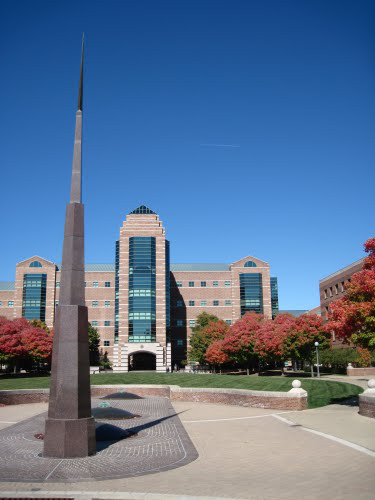Upwells, an astronomical sculpture
Introduction
The sundial is one of mankind's oldest methods of keeping time. It may also be used to monitor the changing of the seasons, to calculate one's latitude, and to make other astronomical measurements. Some of the earliest known sundials were made in Egypt about 1500 B.C. (roughly contemporaneous with the final phases in the construction of Stonehenge), although the study of shadows undoubtedly began in prehistoric times.
A sundial consists of two parts: an upright shaft known as a gnomon and a surface onto which the Sun casts a shadow. Often the surface has various markings to aid in telling the time of day and the seasons. Modest sized sundials are often sold in garden specialty stores. One interesting web site with lots of pictures is the British Sundial Society. An interesting and important variant of the sundial is the cathedral sundial/calendar, in which a small opening in the ceiling of a cathedral allows a beam of light to enter the darkened building. This forms essentially a pinhole camera, allowing an actual image of the Sun to be seen. The location of the image on the cathedral floor records the time of day and the seasons of the year. The astronomer Cassini used such a device in the Bologna cathedral to help confirm Kepler's First Law.
|
A sculpture entitled Upwells is located on the North Part of Campus. It is due south from the Beckman Institute, midway between Springfield and University Avenues, in the courtyard surrounded by the Micro and Nano Technology Lab, the Newmark Lab, and the Coordinated Sciences Lab. Upwells is essentially a large sundial. The tall spire is the gnomon, and the courtyard itself forms the surface on which the shadow is seen. Dome-shaped fountains are placed at certain critical points on the plaza, although no other markings are provided. Notice that this sculpture has an additional feature, a method for sighting the north celestial pole and the star Polaris. |
|
You will need to visit the sculpture on two occasions and make measurements of the shadow cast by the gnomon. You will then use those measurements to determine the time of local noon. With some additional information you will calculate your latitude, the radius of the Earth, and the tilt between the Earth's equator and the plane of the solar system.
Remember that Upwells is, first and foremost, a work of art. As such it is not optimally designed for astronomical measurements. In particular, the shape of the gnomon is such that the shadow it casts is not sharp and well defined. Do the best you can in estimating the position of the shadow.
Observations
Visit the sculpture twice on sunny days when it is possible to see the shadow. For the Fall semester make the first visit as soon as possible and the second again on a day close to September 22nd. For the Spring semester make your visits at least 10 days before and 10 days after the equinox (March 21st). If we are observing daylight savings time, arrive around 12:30 CDT. When we are on standard time, arrive around 11:30 CST. Plan on staying about an hour. Make a precise note of the initial position of the shadow. Then measure the distances from the gnomon to the three domes. Determine as precisely as possible the time when the shadow passes nearest to the center of the middle dome. This is local noon. Measure the length of the shadow at local noon. Before leaving, note the final position of the shadow and compare it with the initial position, in order to determine the direction the shadow is moving.
Look around the plaza/fountain area for some written description. What part of that description is incorrect?
First Visit:
Date: __________________________________________________________
Time of Arrival: ________________________________________________
Describe initial position of shadow: ______________________________________________________________________________________
______________________________________________________________________________________
______________________________________________________________________________________
Distance from gnomon to north dome: ___________________________
Distance from gnomon to middle dome: __________________________
Distance from gnomon to south dome: ___________________________
Time of Local Noon: ___________________________________________
Length of Shadow at Local Noon: _______________________________
Describe final position of shadow: ______________________________________________________________________________________
______________________________________________________________________________________
______________________________________________________________________________________
Time of Departure: ____________________________________________
Second Visit:
Date: _________________________________________________________
Time of Arrival: ______________________________________________
Describe initial position of shadow: ______________________________________________________________________________________
______________________________________________________________________________________
______________________________________________________________________________________
Time of Local Noon: ___________________________________________
Length of Shadow at Local Noon: _______________________________
Describe final position of shadow: ______________________________________________________________________________________
______________________________________________________________________________________
______________________________________________________________________________________
Time of Departure: ____________________________________________
Analysis
Local Noon:
You have measured two values for the time of local noon. What are they? ________________________________________________
Why are they not exactly 12:00? ______________________________________________________________________________________
______________________________________________________________________________________
______________________________________________________________________________________
Do they agree? ________________________________________________
Why might they not agree? ______________________________________________________________________________________
______________________________________________________________________________________
______________________________________________________________________________________
Calculations
Latitude:
Estimate the length of the gnomon's shadow at local noon on a day
close to the equinox.
Assume the spire is 40 feet tall. Calculate your latitude.
Radius of the Earth:
An identical sculpture in New Orleans at local noon on a day close to the equinox would cast a shadow 22 feet long. New Orleans is approximately 700 miles due south of us. Using the method of Eratosthenes, calculate the radius of the Earth. What do you estimate to be the uncertainty in your result?
Tilt of the Earth's Axis:
Assume that the northernmost and southernmost domes mark the position of the shadow at noon on the winter and summer solstices. Use either of those positions to calculate the angle between the equator and the ecliptic. This angle is known as the obliquity of the ecliptic. Use the other position to check your result. This calculation was first known to have been done by the Greek philosopher Oenopides around 475 B. C.
